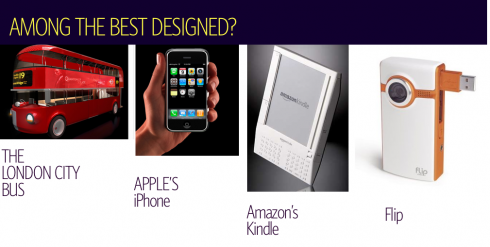
Here is the winning design, by the architects Foster + Partners and the sports car maker Aston Martin, for the new London City bus.
The iPhone: ultimate good design of something that is visually attractive and superbly functional.
The Flip and the Kindle: can we live without them?
And, no, the people debating the question of what constitutes good design in Davos did not include newspapers or websites in their deliberations, which is all right. Design is design, and if one deals with its most philosophical definition—-especially in trying to describe it as good or bad—-then any object would do. Almost everything is “designed” if you will. At the end, good design may be described as that which works (functions?) for a specific subject.
Take one of my favorite gadgets ever, Apple’s iPhone: yes, it is a thing of beauty, and nobody can deny that. But it is also a design that is not only attractive to the eyes , but also to the fingers, the ear, and a product designed to continue to surprise the user long after you have had it: have you tried the new Pandora program? Yes, you can listen to your favorite type of music from one of hundreds of programs. In the case of the iPhone, good design appeals to the imagination as well. No small task.
Alice Rawthorn, who writes about technology for the International Herald Tribune, moderated the discussion at Davos:
Everyone agreed that “good design” had to fulfill its function efficiently. Tim Brown, president of the IDEO design group in San Francisco, used the examples of the Flip video camera and Amazon’s electronic book, the Kindle. “The Flip is a great example of design simplification,” he explained. “Every step of the process of taking, downloading, editing and distributing video has been made simple and seamless. Whereas the Kindle is a great idea, poorly executed. The accidental operation of buttons happens constantly, and it’s uncomfortable to hold, which for a book is a very bad idea. My Kindle sits unused on my desk whereas the Flip goes everywhere.”
Everyone agreed that “good design” had to fulfill its function efficiently. Tim Brown, president of the IDEO design group in San Francisco, used the examples of the Flip video camera and Amazon’s electronic book, the Kindle.
I am disappointed that nobody from the world of media design participated in the Davos debate about good design.
Good design and media
What would be five characteristics that we could have contributed to the definition of good design, especially as applied to newspapers/magazines/online editions:
1. Good design makes the content easy to find.
2. Good design makes the words easy to read.
3. Good design is functional while aesthetically pleasing.
4. Good design does not call attention to itself.
5, Good design is appropriate for the specific product/audience for which it is intended.
For the full article in the International Herald Tribune:
http://www.iht.com/articles/2009/01/30/arts/design2.php

To read TheRodrigoFino blog, in Spanish, go:
https://garciamedia.com/latinamerica/blog/
TheMarioBlog posting # 185